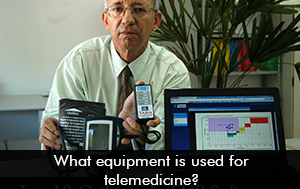Rise and expanded adoption of video chats is a visible example of internet and technological advancements. Telemedicine is now the new way of delivering healthcare. For most of us, healthcare through Telehealth or Telemedicine can be new and scary. Mostly because we can be technologically inept or are unable to answer patient’s questions regarding this remote diagnosis and treatment procedure and in some cases thinking about the costs it entails.
The essential tools or “equipment” necessary for a successful Telehealth experience include carts, configured peripherals, and a robust Telemedicine Electronic Medical Records (EMR) Software. All the frequently asked questions when it comes to telemedicine are (i.e. internet connectivity, data security or privacy policy, health assessment without interaction and payments) can be easily answered through the aforementioned tools.
Hardware Requirements
Commonly used hardware for Telehealth consultations includes carts, peripherals, computers, and tablets. Money can be saved on hardware by selecting an interoperable EMR Software.
Carts– Portable systems used for clinical and educational purposes
Peripherals– Items such as vital sign monitors, digital stethoscopes, probes, spirometers, etc.
Desktop/Laptop Computers– HIPAA-compliant software is installed on these devices to make sure privacy and security.
Tablets/Smartphones– Smartphones and Tablets, such as iPads, are often used now-days to monitor conditions and provide remote consultation.
Software Requirements
On-Call Consultations, Remote Assessments, and Real-Time Monitoring come under the umbrella of Telemedicine, because of which, the selection and implementation of a custom-configured Telemedicine EMR Software is far more crucial than the hardware requirement because the best cloud-based telemedicine EMR Software offer interoperability which allows the Healthcare Software to run seamlessly on multiple devices because of this practices don’t have to invest in new and expensive hardware.
To make your selection easier EMRSystems has compiled a list of Features of Top Telemedicine EMR Software for you to check prior decision.
- Secure Data Sharing through coding and encryption
- High-quality face-to-face and third-party audio and video transmission facility.
- Online Queuing System managing Virtual waiting rooms
- e-Prescribing (e-Rx) automatically sent to patient’s preferred pharmacies
- Automatic Medical Billing after confirming and verifying everything with the insurance provider
Last but not least a secure internet connection is very crucial therefore, efforts are being made to build a stronger broadband infrastructure through the National Broadband Plan. These efforts will resultantly improve On-Call Consultations, Remote Assessments, and Real-Time Monitoring to ensure the best treatment results.
Top Telemedicine EMR Software list by EMRSystems
Research by EMRSystems found the following Electronic Health Records software companies to be the leading vendors to have developed and introduced Telemedicine functionality as part of their core EMR software, Practice Management, and Medical Billing Services portfolio:







